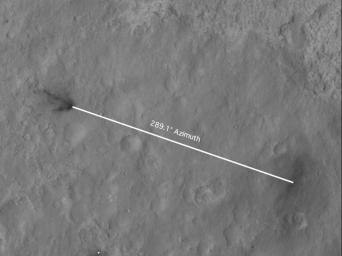
|
Inspecting Curiosity’s Descent Stage Crash Site
- Click the image above for a larger view
- Full-Res JPEG (963 x 720) (57.9 kB)
- Full-Res TIFF (963 x 720) (694.3 kB)
Caption:
This portion of an image from the High Resolution Imaging Science Experiment (HiRISE) on NASA's Mars Reconnaissance Orbiter has been annotated to show the relative positions between NASA's Curiosity rover (right) and the impact site of its sky crane, or descent stage. The azimuth from north of the rover is about 290 degrees (north is up and zero degrees).
This information was used to determine whether the rover was pointed in the right direction to have captured an image of the plume from the crash of the descent stage using its rear-facing Hazard-Avoidance cameras. The gyrocompass on Curiosity indicates that the rover is pointed at 112 degrees, which, after subtracting 180 degrees since the picture was taken from the rear, gives the same direction of the sky crane crash to within 2 degrees.
Background Info:
HiRISE is one of six instruments on NASA's Mars Reconnaissance Orbiter. The University of Arizona, Tucson, operates the orbiter's HiRISE camera, which was built by Ball Aerospace & Technologies Corp., Boulder, Colo. NASA's Jet Propulsion Laboratory, a division of the California Institute of Technology in Pasadena, manages the Mars Reconnaissance Orbiter Project for NASA's Science Mission Directorate, Washington. Lockheed Martin Space Systems, Denver, built the spacecraft.
Cataloging Keywords:
| Name | Value | Additional Values |
|---|---|---|
| Target | Mars | |
| System | ||
| Target Type | Planet | |
| Mission | Mars Science Laboratory (MSL) | Mars Reconnaissance Orbiter (MRO) |
| Instrument Host | Curiosity Rover | Mars Reconnaissance Orbiter |
| Host Type | Rover | Orbiter |
| Instrument | ||
| Detector | ||
| Extra Keywords | Grayscale, Impact, Plume | |
| Acquisition Date | ||
| Release Date | 2012-08-10 | |
| Date in Caption | ||
| Image Credit | NASA/JPL-Caltech/University of Arizona | |
| Source | photojournal.jpl.nasa.gov/catalog/PIA16023 | |
| Identifier | PIA16023 | |
